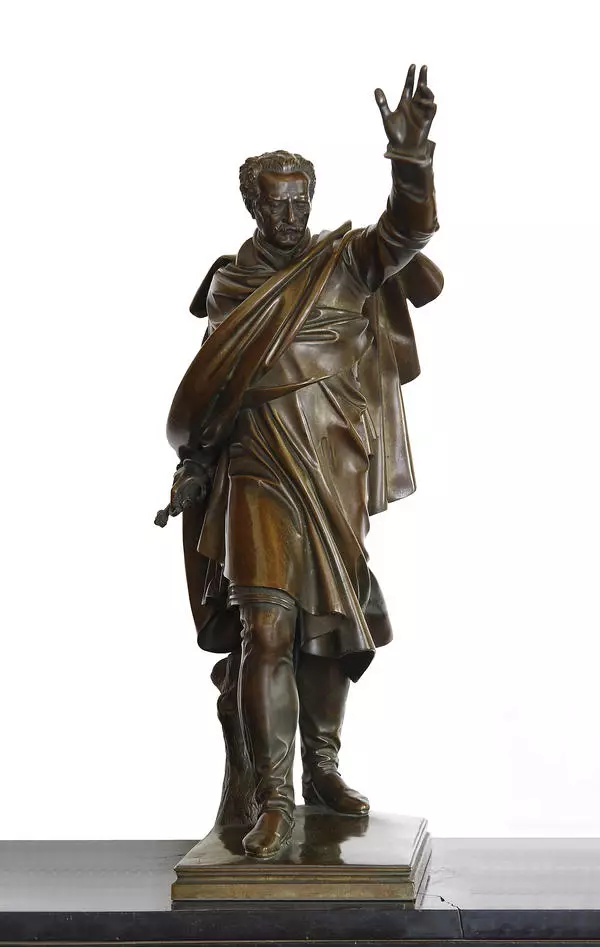After the beginning of the nationalization of the noble estates, objects of artistic value entered the museums of the provincial cities or were exported to the Russian central museums. Thus, the bust of Nicholas I by Christian Rauch came to the Smolensk Museum-Reserve collection in 1923.
The portrait of Nicholas I is one of the author’s repetitions of the famous bust of Nikolai Pavlovich, created by Rauch in 1821, during the Grand Duke’s stay in Berlin with his wife. Subsequently, when Nikolai ascended the throne, the sculptor repeatedly turned to this work, repeating it and making changes corresponding to the new status of the model.
The emperor is depicted in the romantic antique style typical of that period. Nikolai Pavlovich is dressed in ancient Roman scaly armor. Along the edge, the armor is decorated with a meander — a pattern in the form of a stylized wave. A cloak decorated with the figure of the Goddess of Glory is draped over the shoulders of the emperor. In one hand, the goddess holds a trumpet, and in the other — a palm branch, a symbol of the victors. Nicholas I is depicted in an energetic turn to the left, his gaze is directly at the viewer. The emperor’s hairstyle also reminds of a connection with Roman mythology. The sculptor creates the image of the victorious emperor, creator, hero.
Christian Daniel Rauch is considered the founder of one of the most expressive trends in German sculpture of the 19th century — Prussian Hellenism. Rauch’s work arose across classicism and romanticism. The sculptor’s works were widely known throughout Europe. He carried out orders for many reigning houses. By order of the imperial house, Rauch created a statue of the Russian Emperor Alexander I. He worked on the orders of Nicholas I. Allegorical winged figures of Victory for the columns installed on Konnogvardeisky Boulevard in St. Petersburg in 1845-1846 were made based on Rauch’s models. Rauch’s most famous monumental work is the equestrian statue of Frederick the Great in Berlin.
For many years, the bust of Rauch’s work was in the storerooms of the Smolensk Museum-Reserve and only recently was included in a new exposition.
The portrait of Nicholas I is one of the author’s repetitions of the famous bust of Nikolai Pavlovich, created by Rauch in 1821, during the Grand Duke’s stay in Berlin with his wife. Subsequently, when Nikolai ascended the throne, the sculptor repeatedly turned to this work, repeating it and making changes corresponding to the new status of the model.
The emperor is depicted in the romantic antique style typical of that period. Nikolai Pavlovich is dressed in ancient Roman scaly armor. Along the edge, the armor is decorated with a meander — a pattern in the form of a stylized wave. A cloak decorated with the figure of the Goddess of Glory is draped over the shoulders of the emperor. In one hand, the goddess holds a trumpet, and in the other — a palm branch, a symbol of the victors. Nicholas I is depicted in an energetic turn to the left, his gaze is directly at the viewer. The emperor’s hairstyle also reminds of a connection with Roman mythology. The sculptor creates the image of the victorious emperor, creator, hero.
Christian Daniel Rauch is considered the founder of one of the most expressive trends in German sculpture of the 19th century — Prussian Hellenism. Rauch’s work arose across classicism and romanticism. The sculptor’s works were widely known throughout Europe. He carried out orders for many reigning houses. By order of the imperial house, Rauch created a statue of the Russian Emperor Alexander I. He worked on the orders of Nicholas I. Allegorical winged figures of Victory for the columns installed on Konnogvardeisky Boulevard in St. Petersburg in 1845-1846 were made based on Rauch’s models. Rauch’s most famous monumental work is the equestrian statue of Frederick the Great in Berlin.
For many years, the bust of Rauch’s work was in the storerooms of the Smolensk Museum-Reserve and only recently was included in a new exposition.





